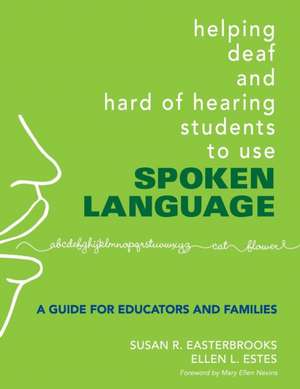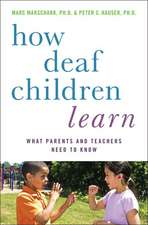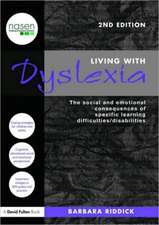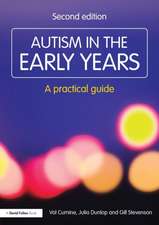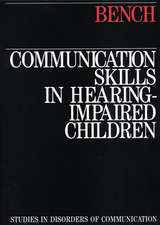Helping Deaf and Hard of Hearing Students to Use Spoken Language: A Guide for Educators and Families
Autor Susan Easterbrooks, Ellen L. Estesen Limba Engleză Paperback – 23 iul 2007
· Materials have been tried-and-tested with the deaf and hard of hearing, their teachers and practising professionals
· Each chapter includes chapter objectives, questions, summaries, case-studies, problems, bibliographies and appendices.
Toate formatele și edițiile
| Toate formatele și edițiile | Preț | Express |
|---|---|---|
| Paperback (1) | 343.77 lei 43-57 zile | |
| SAGE Publications – 23 iul 2007 | 343.77 lei 43-57 zile | |
| Hardback (1) | 605.22 lei 43-57 zile | |
| SAGE Publications – 23 iul 2007 | 605.22 lei 43-57 zile |
Preț: 343.77 lei
Nou
Puncte Express: 516
Preț estimativ în valută:
65.80€ • 71.50$ • 55.31£
65.80€ • 71.50$ • 55.31£
Carte tipărită la comandă
Livrare economică 21 aprilie-05 mai
Preluare comenzi: 021 569.72.76
Specificații
ISBN-13: 9781412927338
ISBN-10: 1412927331
Pagini: 224
Dimensiuni: 216 x 279 x 14 mm
Greutate: 0.63 kg
Ediția:1
Editura: SAGE Publications
Colecția Corwin
Locul publicării:Thousand Oaks, United States
ISBN-10: 1412927331
Pagini: 224
Dimensiuni: 216 x 279 x 14 mm
Greutate: 0.63 kg
Ediția:1
Editura: SAGE Publications
Colecția Corwin
Locul publicării:Thousand Oaks, United States
Recenzii
"Great for parents, people entering the field of audiology, teaching the deaf, or anyone unfamiliar with hearing loss."
"The way the many complexities of speech are discussed, explained, and addressed is very reader-friendly, easy to understand, and accessible."
"Real-world examples that reinforce teachings accompany analytical and framework viewpoints, making this a valuable library reference and text recommended for student teaching classrooms and college-level educator's libraries alike."
“Designed to enlighten educators, parents, and professionals serving children with hearing loss. However, the novice is likely to gain immense insight from this text because of its readability and excellent descriptions of language acquisition in a range of situations. The techniques explained are supported by research, and the authors have done a good job of highlighting appropriate interventions to help students succeed.”
"The way the many complexities of speech are discussed, explained, and addressed is very reader-friendly, easy to understand, and accessible."
"Real-world examples that reinforce teachings accompany analytical and framework viewpoints, making this a valuable library reference and text recommended for student teaching classrooms and college-level educator's libraries alike."
“Designed to enlighten educators, parents, and professionals serving children with hearing loss. However, the novice is likely to gain immense insight from this text because of its readability and excellent descriptions of language acquisition in a range of situations. The techniques explained are supported by research, and the authors have done a good job of highlighting appropriate interventions to help students succeed.”
Cuprins
Foreword (by Mary Ellen Nevins, EdD)
Preface
Acknowledgements
About the Authors
Part 1: The Art of Intervention
1. Listening and Spoken Language Interventions: A Model and Activities for Helping Children
Listening Challenges That Children Must Overcome
Model of Auditory, Speech, and Language Development
Summary
2. Early Detection and Intervention for Infants and Toddlers
Early Detection and Intervention
Necessary Services for Infants, Toddlers, and Their Families
How Listening Develops in Infants and Toddlers
How Infants Develop Spoken Language
How Toddlers Develop Spoken Language
Interventions for Babies
Applying the Model With Babies
Interventions for Toddlers
Applying the Model With Toddlers
If a Child Is Not Making Measurable Progress
The Need for Flexible Models
Summary
3. Intervention for Preschoolers
Collaborating With Service Providers
What You Need to Know About a Child's Hearing Loss
What You Need to Know About Previous Intervention
What You Need to Know About Listening Technology
What You Need to Know About a Child With No Prior Services
Planning and Implementing Instruction and Interventions
Factors to Consider When Planning Lessons
Techniques to Use When Conducting a Lesson
Interventions for Preschoolers
Applying the Model With Preschoolers
Summary
4. Interventions for Children in the Primary Grades
A Typical Day in the Life of the Young Student With a Hearing Loss
The Effects of Hearing Loss in the Classroom
Assessing a Child's Present Levels of Performance
The Multidisciplinary Team of Professionals Who Can Assist the Teacher
Readiness for School
Instructional Considerations
Interventions for Children in the Primary Grades
Applying the Model With Kindergartners and Early Elementary Children
Summary
5. Developing Literacy Skills in Children With Hearing Losses
Learning to Read
Effective Approaches to Reading
Using Reading to Develop Language - A Paradox
Assessment
Implications for the Special Education Teacher
Implications for the General Education Teacher
Intervention
The Literacy Team
Summary
Part 2: The Science of Intervention
6. How Children Hear and Talk: Fundamentals of Listening and Speaking
The Speech Chain
Linguistic Level
Physiological Level: The Physiology of Speech
Physiological Level: The Physiology of Hearing
Acoustic Level
Hearing Aids, Cochlear Implants, and Assistive Listening Devices
Classroom Acoustics - Increasing the Child's Ability to Hear and Understand the Teacher and Peers
Daily Device Monitoring: Your Responsibility
How to Give the Ling Sound Check
Summary
Resource A: Organizations and Agencies Serving Children With Hearing Losses
Resource B: Assessments
Resource C: Sound-Object Associations (by Ellen A. Rhoades, EdS)
Resource D: Commercially Available Curriculum Guides and Materials
References
Index
Preface
Acknowledgements
About the Authors
Part 1: The Art of Intervention
1. Listening and Spoken Language Interventions: A Model and Activities for Helping Children
Listening Challenges That Children Must Overcome
Model of Auditory, Speech, and Language Development
Summary
2. Early Detection and Intervention for Infants and Toddlers
Early Detection and Intervention
Necessary Services for Infants, Toddlers, and Their Families
How Listening Develops in Infants and Toddlers
How Infants Develop Spoken Language
How Toddlers Develop Spoken Language
Interventions for Babies
Applying the Model With Babies
Interventions for Toddlers
Applying the Model With Toddlers
If a Child Is Not Making Measurable Progress
The Need for Flexible Models
Summary
3. Intervention for Preschoolers
Collaborating With Service Providers
What You Need to Know About a Child's Hearing Loss
What You Need to Know About Previous Intervention
What You Need to Know About Listening Technology
What You Need to Know About a Child With No Prior Services
Planning and Implementing Instruction and Interventions
Factors to Consider When Planning Lessons
Techniques to Use When Conducting a Lesson
Interventions for Preschoolers
Applying the Model With Preschoolers
Summary
4. Interventions for Children in the Primary Grades
A Typical Day in the Life of the Young Student With a Hearing Loss
The Effects of Hearing Loss in the Classroom
Assessing a Child's Present Levels of Performance
The Multidisciplinary Team of Professionals Who Can Assist the Teacher
Readiness for School
Instructional Considerations
Interventions for Children in the Primary Grades
Applying the Model With Kindergartners and Early Elementary Children
Summary
5. Developing Literacy Skills in Children With Hearing Losses
Learning to Read
Effective Approaches to Reading
Using Reading to Develop Language - A Paradox
Assessment
Implications for the Special Education Teacher
Implications for the General Education Teacher
Intervention
The Literacy Team
Summary
Part 2: The Science of Intervention
6. How Children Hear and Talk: Fundamentals of Listening and Speaking
The Speech Chain
Linguistic Level
Physiological Level: The Physiology of Speech
Physiological Level: The Physiology of Hearing
Acoustic Level
Hearing Aids, Cochlear Implants, and Assistive Listening Devices
Classroom Acoustics - Increasing the Child's Ability to Hear and Understand the Teacher and Peers
Daily Device Monitoring: Your Responsibility
How to Give the Ling Sound Check
Summary
Resource A: Organizations and Agencies Serving Children With Hearing Losses
Resource B: Assessments
Resource C: Sound-Object Associations (by Ellen A. Rhoades, EdS)
Resource D: Commercially Available Curriculum Guides and Materials
References
Index
Notă biografică
Dr. Susan R. Easterbrooks is a Professor of Deaf Education in the Educational Psychology Department in the College of Education at Georgia State University and has been active in the field of deaf education for over 30 years. Dr. Easterbrooks has been a teacher, clinician, administrator, school psychologist, lecturer, and consultant and has authored numerous articles, chapters, and books on the education of children who are deaf and hard of hearing. She has participated actively on various local, state, and national committees. She currently serves as chair of the committee revising Knowledge and Skills Needed by Teachers of the Deaf and Hard of Hearing for the Division for Communicative Disabilities and Deafness of the Council for Exceptional Children. She participated in the development and revision of guidelines for services to students with hearing loss, published by the National Association of State Directors of Special Education and on the Special Needs committee of the National Board for Professional Teaching Standards. Dr. Easterbrooks resides in Gainesville, Georgia with her husband and son.
Descriere
Based on the authors' model of auditory, speech, and language development, the book provides educators with effective techniques and strategies for working with children in the primary grades.
